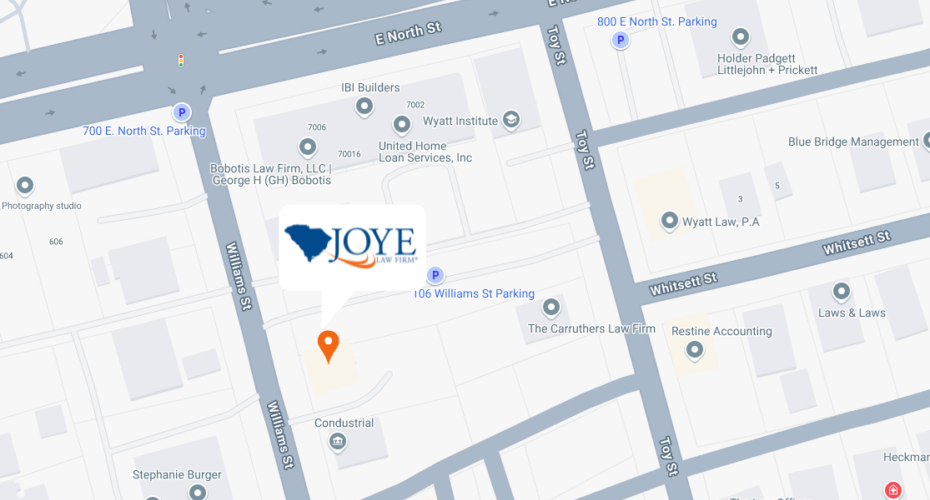
Willie Robertson dedicated nearly 40 years to his job at a North Charleston factory. When he realized that his long-term noise exposure had led to hearing loss, he assumed his company would cover the cost of hearing aids.
Unfortunately, he was mistaken. Not only did the company refuse to pay for the hearing aids, but they also denied any connection between his hearing loss and his work. Frustrated, Willie reached out to Joye Law Firm. Our workers’ compensation attorneys not only secured his hearing aids but also obtained additional benefits for him.
South Carolina’s workers’ compensation laws cover employees who develop a work-related illness, but it isn’t always clear who is eligible. Many workers, like Willie, face an uphill battle in proving their job caused their illness. Read on to learn when an illness is covered under workers’ compensation in South Carolina and how Joye Law Firm can help ensure you receive the benefits you deserve.
Does Workers’ Compensation Cover Illnesses?
While most people associate workers’ compensation with physical on-the-job injuries, South Carolina law also offers workers’ comp to employees who become sick due to their jobs.
However, catching a cold or flu at work does not make you eligible for workers’ compensation. To receive workers’ comp, the illness, referred to as an “occupational disease” in workers’ compensation claims, must be:
- Caused directly by your work duties
- A condition not considered an “ordinary disease of life,” like a cold or flu
- Unrelated to the outside climate
- Transmitted by someone other than a colleague
- Unrelated to your joints
Some illnesses also have specific requirements to be eligible for workers’ comp. For example, if your occupational disease affects your heart or lungs, the sickness must result from exposure to a harmful substance at work.
Occupational Diseases Covered under Workers’ Comp
 Occupational diseases can affect various parts of the body and range from mild conditions that improve with rest to severe, progressive diseases that may lead to death. Here are some common examples of illnesses that are covered under workers’ comp:
Occupational diseases can affect various parts of the body and range from mild conditions that improve with rest to severe, progressive diseases that may lead to death. Here are some common examples of illnesses that are covered under workers’ comp:
Respiratory Diseases
Respiratory diseases related to work involve conditions that impact the lungs and respiratory system, often due to exposure to harmful substances such as dust, fumes, and chemicals. Common work-related respiratory diseases include:
- Asthma: Triggered or worsened by workplace irritants like fumes, chemicals, or dust, affecting workers in industries such as healthcare, manufacturing, and cleaning services.
- Silicosis: Found in miners and stonecutters, this disease results from inhaling silica dust over long periods, leading to symptoms such as a persistent cough, shortness of breath, and chest pain.
- Chronic Obstructive Pulmonary Disease (COPD): This progressive condition is aggravated by exposure to fumes, chemicals, and dust, particularly in industries like mining and manufacturing.
Cancer
Occupational cancers result from long-term exposure to hazardous substances or conditions, including:
- Chemicals: Such as benzene, formaldehyde, and arsenic
- Radiation
- Heavy Metals: Like cadmium, chromium, and nickel
- Silica Dust
- Wood Dust
- Textile Fibers
- Pesticides
- Asbestos
Exposure to certain irritants has been scientifically linked to specific types of cancer. Mesothelioma, a type of cancer linked to asbestos, is particularly notable. Workers in construction, shipbuilding, and automotive repair face a higher risk of exposure to asbestos and, consequently, mesothelioma. This cancer often takes decades to develop, making early detection challenging and prognosis generally poor.
Skin Conditions
Occupational skin conditions can significantly affect a worker’s quality of life. The most common condition is contact dermatitis, characterized by red, itchy, and inflamed skin, often due to exposure to irritants or allergens such as:
- Solvents
- Detergents
- Oils
- Rubber
- Latex
- Certain Plants
Hearing Loss
Occupational hearing loss results from prolonged exposure to high noise levels or ototoxic chemicals (like lead, pesticides, and mercury). Common in industries with heavy machinery, construction, mining, and manufacturing, this type of hearing loss is usually irreversible. Preventive measures, including hearing protection and regular hearing tests, are essential for early detection and mitigation.
Musculoskeletal Disorders (MSDs)
MSDs affect the muscles, joints, tendons, ligaments, and nerves. They often result from repetitive actions, heavy lifting, or awkward body positions during work. Examples include:
- Carpal Tunnel Syndrome: A nerve disorder affecting the hands and wrists, often seen in repetitive tasks like typing or assembly line work.
- Tendonitis: Involves inflammation or irritation of a tendon due to repetitive motion or forceful exertion.
- Arthritis: May develop or worsen from repetitive tasks, heavy lifting, or prolonged sitting or standing.
- Tennis Elbow: Pain in the outer elbow from repetitive wrist and arm motions.
- Trigger Finger: A condition where a finger or thumb gets stuck in a bent position, often due to frequent grasping or repetitive hand use.
Chronic Pain Syndrome
Chronic pain syndrome involves persistent pain lasting more than three months, often exacerbated by repetitive motion, heavy lifting, or prolonged sitting or standing. Unlike acute pain, which resolves with treatment, chronic pain can interfere with job performance and quality of life.
Understanding these occupational diseases is crucial for recognizing symptoms and seeking appropriate medical care and compensation.












